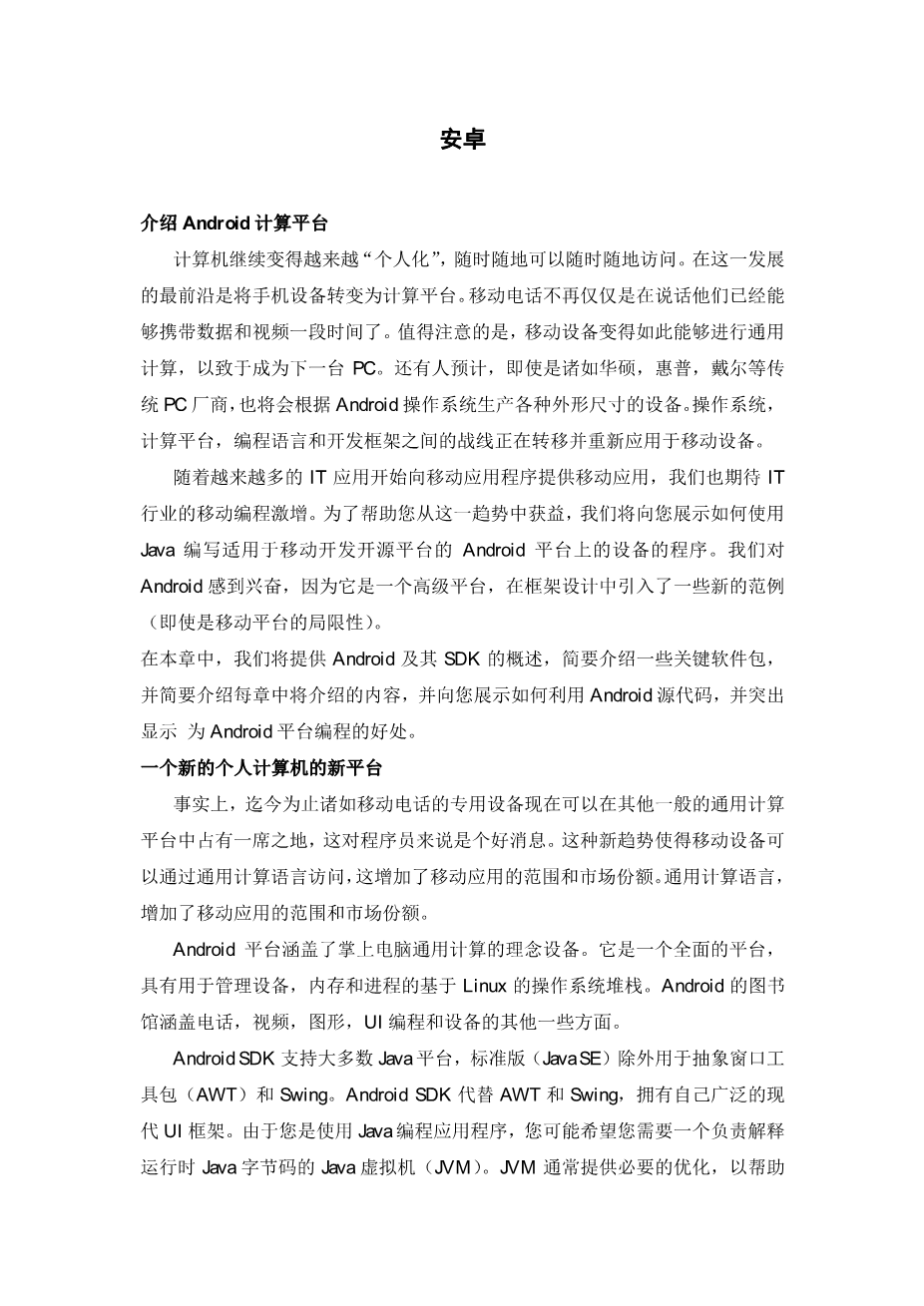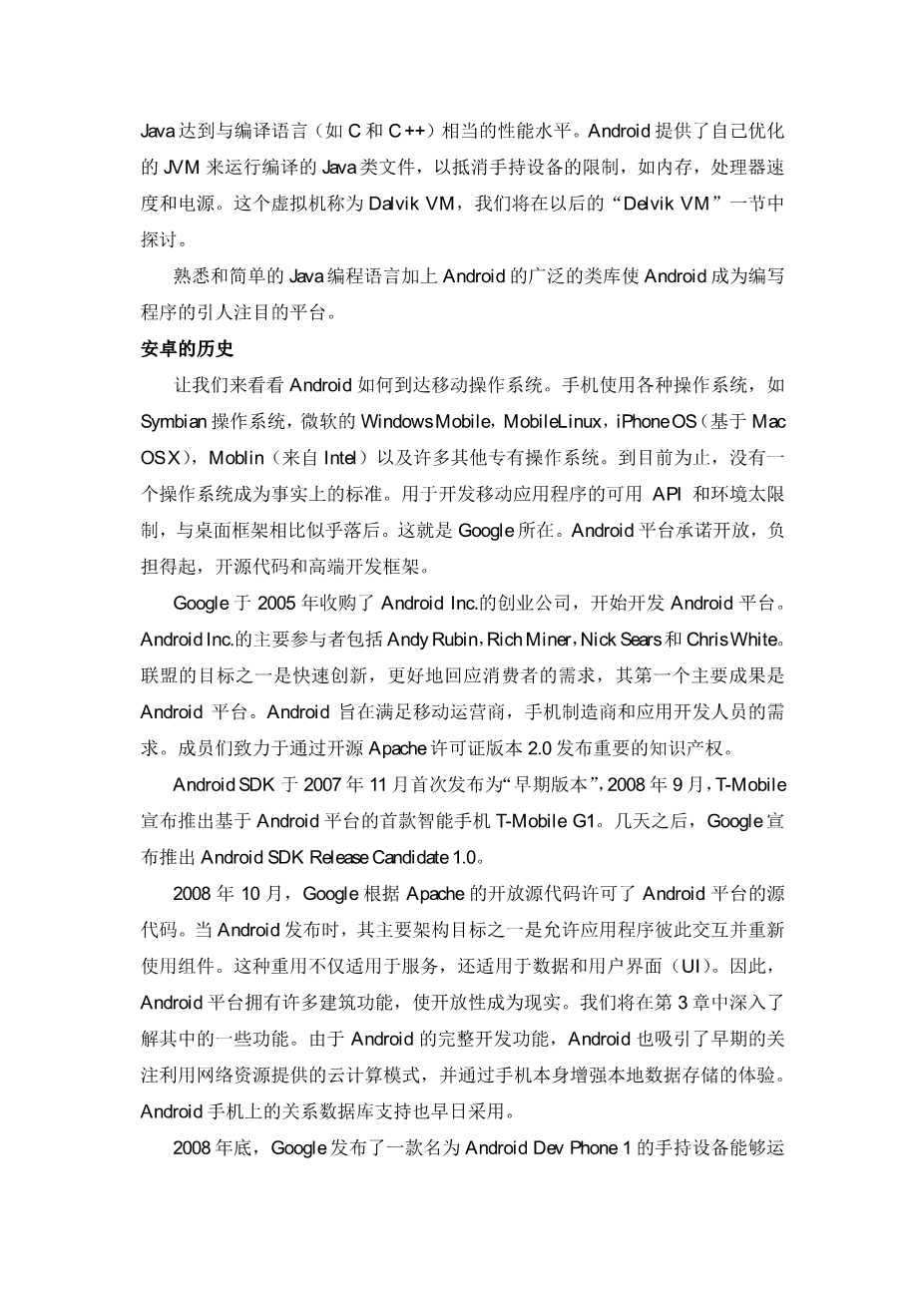安卓外文翻译资料
2022-08-12 16:48:21
Android
Introducing the Android Computing Platform
Computing continues to become more “personal,” increasingly accessible anytime,anywhere.At the forefront of this development are handheld devices that are transforming into computing platforms. Mobile phones are no longer just for talking—they have been capable of carrying data and video for some time. Significantly, the mobile device is becoming so capable of general-purpose computing that itrsquo;s destined to become the next PC (Personal Computer). It is also anticipated that even a number of traditional PC manufacturers such as ASUS, HP, and Dell will be producing devices of various form factors based on the Android OS. The battle lines between operating systems, computing platforms, programming languages, and development frameworks are being shifted and reapplied to mobile devices.
We are also expecting a surge in mobile programming in the IT industry as more and more IT applications start to offer mobile counterparts. To help you profit from this trend,wersquo;ll show you how to use Java to write programs for devices that run on Googlersquo;s Android Platform, an open source platform for mobile development. We are excited about Android because it is an advanced platform that introduces a number of new paradigms in framework design (even with the limitations of a mobile platform).
In this chapter, wersquo;ll provide an overview of Android and its SDK, give a brief overview of key packages, introduce what we are going to cover in each chapter briefly, show you how to take advantage of Android source code, and highlight the benefits of programming for the Android Platform.
A New Platform for a New Personal Computer
The fact that hitherto dedicated devices such as mobile phones can now count themselves among other venerable general-computing platforms is great news for programmers . This new trend makes mobile devices accessible through general-purpose computing languages, which increases the range and market share for mobile applications. general-purpose computing languages, which increases the range and market share for mobile applications.
The Android Platform embraces the idea of general-purpose computing for handheld devices. It is a comprehensive platform that features a Linux-based operating system stack for managing devices, memory, and processes. Androidrsquo;s libraries cover telephony, video, graphics, UI programming, and a number of other aspects of the device.
The Android SDK supports most of the Java Platform, Standard Edition (Java SE) except for the Abstract Window Toolkit (AWT) and Swing. In place of AWT and Swing, AndroidSDK has its own extensive modern UI framework. Because yoursquo;re programming your applications in Java, you could expect that you need a Java Virtual Machine (JVM) that is responsible for interpreting the runtime Java byte code. A JVM typically provides the necessary optimization to help Java reach performance levels comparable to compiled languages such as C and C . Android offers its own optimized JVM to run the compiled Java class files in order to counter the handheld device limitations such as memory, processor speed, and power. This virtual machine is called the Dalvik VM,which wersquo;ll explore in a later section “Delving into the Dalvik VM.”
The familiarity and simplicity of the Java programming language coupled with Androidrsquo;s extensive class library makes Android a compelling platform to write programs for.
History of Android
Let us look at how Android arrived on the Mobile OS landscape. Mobile phones use a variety of operating systems such as Symbian OS, Microsoftrsquo;s Windows Mobile, MobileLinux, iPhone OS (based on Mac OS X), Moblin (from Intel), and many other proprietary OSs. So far no single OS has become the de facto standard. The available APIs and environments for developing mobile applications are too restrictive and seem to fall behind when compared to desktop frameworks. This is where Google comes in. The Android platform promised openness, affordability, open source code, and a high-end development framework.
Google acquired the startup company Android Inc. in 2005 to start the development of the Android Platform. The key players at Android Inc. included Andy Rubin, Rich Miner, Nick Sears, and Chris White.
Part of the alliancersquo;s goal is to innovate rapidly and respond better to consumer needs,and its first key outcome was the Android Platform. Android was designed to serve the needs of mobile operators, handset manufacturers, and application developers. The members have committed to release significant intellectual property through the open source Apache License, Version 2.0.
The Android SDK was first issued as an “early look” release in November 2007. In September 2008, T-Mobile announced the availability of T-Mobile G1, the first smartphone based on the Android platform. A few days after that, Google announcedthe availability of Android SDK Release Candidate 1.0. In October 2008, Google made the source code of the Android platform available under Apachersquo;s open source license.
When Android was released, one of its key architectural goals was to allow applications
to interact with one another and reuse components from one another. This reuse not only applies to services, but also to data and the user interface (UI). As a result, the Android platform has a number of architectural features that keep this openness a reality. Wersquo;ll delve into some of these features in Chapter 3.
Android has also attracted an early following because of its fully developed features to exploit the cloud-computing model offered by web resources and to enhance that experience with local data stores on the handset itself. Androidrsquo;s support for a relational database on the handset also played a part in early adoption.
In late 2008 Google released a handheld device
剩余内容已隐藏,支付完成后下载完整资料


英语译文共 7 页,剩余内容已隐藏,支付完成后下载完整资料
资料编号:[484684],资料为PDF文档或Word文档,PDF文档可免费转换为Word
课题毕业论文、开题报告、任务书、外文翻译、程序设计、图纸设计等资料可联系客服协助查找。



